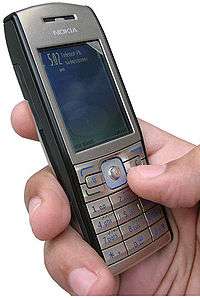Nokia E50
 | |
| Manufacturer | Nokia |
|---|---|
| Compatible networks | EGSM 850/900/1800/1900 |
| Predecessor | Nokia 6230 |
| Successor | Nokia E51 |
| Form factor | Candybar |
| Dimensions | 113 × 43.5 × 15.5 millimeters |
| Weight | 104 g (0.229 lb) |
| Operating system | S60 3rd edition on Symbian OS v9.1 |
| CPU | ARM 9 @ 235 MHz |
| Memory | 70 MB (internal) |
| Removable storage | MicroSD |
| Battery | BL-5C (970 mAh) or BL-6C (1150 mAh) |
| Display | 2.06 in, 31×42 mm, 240×320 pixels, Active Matrix, 262,144 colours |
| Rear camera | 1,280×960 pixels (1.3-megapixel), 4× digital zoom |
| Connectivity | USB Mass Storage via Pop-Port, Bluetooth 2.0, Infrared |


The Nokia E50 Business Device is a bar-style monoblock quad-band smartphone from Nokia announced 18 May 2006[1] as part of the Eseries, intended primarily for the corporate business market. It includes sophisticated e-mail support for Nokia’s Intellisync Wireless Email, BlackBerry Connect, Visto Mobile, Activesync Mail for Exchange, Altexia as well as IMAP4. It also has the ability to view Microsoft Word, PowerPoint, and Excel attachments, and PDF documents but it cannot be used for editing these without additional apps. An application manager downloads, removes and installs both Nokia and third-party applications. Device to device synchronization is possible with Data transfer application. Features include EDGE, Bluetooth 2.0, a 1,280 × 960 pixels (1.3-megapixel) camera, a MicroSD memory-card slot, and digital music and video player functionality through RealPlayer and Flash Player. This unit does not support UMTS, Wi-Fi, or FM radio.
It uses the third edition of the Series 60 user-interface (S60v3) and the Symbian operating system version 9.1. It is not binary compatible with software compiled for earlier versions of the Symbian operating system.
Versions
Check firmware
*#0000#
V 07.36.0.0[2]
- Nokia model E50-1 / RM-170 (with camera)
- Nokia model E50-2 / RM-171 (without camera)
- Nokia model E50 Metal Black, available in selected markets.[3]
Specifications sheet
| Feature | Specification |
|---|---|
| Form factor | Candybar / Monoblock |
| Operating System | Symbian OS (9.1) + Series 60 v3 |
| GSM frequencies | 850/900/1800/1900 MHz |
| GPRS | Yes, class 10 |
| EDGE (EGPRS) | Yes, class 10 |
| 3G | No |
| UMTS/WCDMA | No |
| WLAN/WiFi | No |
| PG.R.S. support | Yes |
| Main screen | Active Matrix, 262 144 colours, 240 × 320 pixels, adjustable brightness |
| Camera (optional) | 1,280 × 960 pixels (1.3-megapixel), 4x digital zoom |
| Video recording | Yes 176 × 144 or 128 × 96, 15 frames per second, up to one hour |
| Voice recording | Yes |
| Multimedia Messaging | Yes |
| Video calls | No |
| Push to talk | Yes (Push to Talk over Cellular – PoC) |
| Java support | Yes, MIDP 2.0 |
| Built-in memory | 70 MB |
| Memory card slot | Yes, MicroSD/TransFlash max. 2 GB |
| Hot Swappable Memory card slot | Yes |
| Bluetooth | Yes v2.0 + EDR |
| Infrared | Yes |
| USB Mass Storage | Yes, via Pop-Port |
| Data cable support | Yes |
| Browser | WAP 2.0 XHTML / HTML. Comes standard with a full Nokia Mini Map Browser |
| Yes | |
| Music player | Yes, stereo |
| Radio FM | No |
| Video Player | Yes |
| Stereo Speakers | No |
| Ringtones | Yes, Polyphonic, Monophonic, MP3, True Tones |
| Vibrate | Yes |
| HandsFree (HF) speakerphone | Yes |
| Offline/Flight mode | Yes |
| Battery | BL-5C (970 mAh) or BL-6C (1,150 mAh) |
| Talk time | 6.8 / 8 hours |
| Standby time | 9 days / 10 days |
| Weight | 104 grams |
| Dimensions | 113 × 43.5 × 15.5 millimeters |
| Availability | Q3 2006 |
| Else | Nokia PC Suite, iSync |
BT profiles
- Audio
- AVCTP-CT (Audio/Video Control Transport Protocol Controller)
- AVCTP-TG (Audio/Video Control Transport Protocol Target)
- AVRCP-TG (Audio Video Remote Control TG)
- GAVDP-ACP (Generic Audio/Video Distribution Profile Acceptor)
- GAVDP-INT (Generic Audio Video Distribution Initiator)
- HandsFree-AG (1.0) (HandsFree Audio Gateway)
- Headset-AG (Headset Audio Gateway)
- SIM Access-Server
- File transfer
- FT-Server (File Transfer Server)
- Photo
- BIP-ImagePush (Basic Imaging)
- Generic
- GAP (Generic Access)
- Internet/LAN
- DUN-GW (Dial-Up Networking Gateway)
- PAN-AP (Personal Area Networking Access Point)
- PAN-Group
- Serial communication
- Serial-DevA
- Serial-DevB
- Control
- HID-Host (Human Interface Device Host)
- Business card
- OPP Client (Object Push Profile)
- OPP Server
See also
References
- ↑ "The smallest of Nokia Eseries, the Nokia E50 business device for mobile professionals" (Press release). Nokia. 18 May 2006. Retrieved 28 May 2006.
- ↑ Nokia Firmware Versions
- ↑ Nokia E50 Key Features
External links
| Wikimedia Commons has media related to Nokia E50. |
- Nokia E50 – Product Page
- Nokia E50 – Resource Information
- Nokia E50 – Device Details
- Bluetooth Qualification Program specifications
- Repair Video
Reviews, photos and videos
- Nokia E50 – Review by Mobile-Review
- Nokia E50 – Review by phoneArena.com
- Nokia E50 – Review by GSM Arena, Video
- Nokia E50 – Review by About-nokia.com
- Nokia E50 – Preview by All About Symbian
- Nokia E50 – Review by CNET: UK
- Nokia E50 – Review by Tech2 India
- Nokia E50 – Review by Steve Punter's Southern Ontario Cell Phone Page
- Nokia E50 – Unofficial Live Photos of 'Metal Black' model
- Nokia E50 – Official Photos of 'Metal Black' model
- Nokia E50 – Official Photos
- Nokia E50 – Official Video